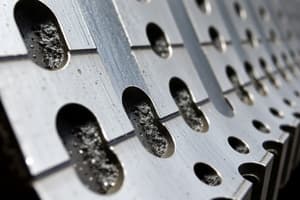Podcast
Questions and Answers
What is tensile strength primarily concerned with?
What is tensile strength primarily concerned with?
- Resistance to being pulled apart (correct)
- Ability to withstand axial loads
- Ability to absorb energy during deformation
- Resistance to surface deformation
Which property quantifies a material's ability to return to its original shape after deformation?
Which property quantifies a material's ability to return to its original shape after deformation?
- Brittleness
- Ductility
- Plasticity
- Elasticity (correct)
What does compressive strength measure?
What does compressive strength measure?
- Strength under repeated loading
- Ability to withstand axial loads that shorten a material (correct)
- Resistance against sliding along a plane
- Ability to resist deformation under load
Which property does NOT reflect a material's toughness?
Which property does NOT reflect a material's toughness?
What is the primary consequence of fatigue in materials?
What is the primary consequence of fatigue in materials?
How is hardness typically measured?
How is hardness typically measured?
Which property describes a material's ability to deform permanently without breaking?
Which property describes a material's ability to deform permanently without breaking?
What impact does creep have on materials?
What impact does creep have on materials?
Flashcards are hidden until you start studying
Study Notes
Material Strength
- Definition: The ability of a material to withstand an applied load without failure.
- Types of Strength:
- Tensile Strength: Resistance to being pulled apart; measured as maximum stress a material can sustain.
- Compressive Strength: Ability to withstand axial loads that compress or shorten the material.
- Shear Strength: Resistance to sliding or deformation along a plane; critical in materials subjected to shear forces.
- Flexural Strength: Ability to resist deformation under load; important in beam applications.
- Fatigue Strength: Strength of a material under repeated loading; determines lifespan under cyclic stress.
- Impact Strength: Ability to absorb energy during plastic deformation; critical in dynamic loading scenarios.
Mechanical Properties Of Materials
- Elasticity: Ability of a material to return to its original shape after deformation; characterized by the modulus of elasticity.
- Plasticity: The ability to undergo permanent deformation without breaking; materials can be shaped or molded.
- Ductility: Measure of a material's ability to deform under tensile stress; ductile materials can be stretched into wires.
- Brittleness: Tendency of a material to fracture without significant deformation; opposite of ductility.
- Hardness: Resistance to surface deformation, scratching, or abrasion; often measured via tests like Rockwell or Brinell.
- Toughness: Ability to absorb energy and plastically deform without fracturing; a combination of strength and ductility.
- Creep: Time-dependent deformation under constant stress; significant at high temperatures and can lead to failure in some materials.
- Fatigue: Progressive and localized structural damage that occurs when a material is subjected to cyclic loading.
- Thermal Properties: Heat resistance, thermal expansion, and conductivity affect a material’s performance under temperature changes.
Summary
Understanding the strength of mechanics involves comprehending both material strength and the mechanical properties of materials. Knowledge of these concepts is crucial for designing structures and components that can safely withstand operational loads and environmental conditions.
Material Strength
- Material strength refers to its capacity to endure applied loads without failing.
- Tensile Strength: Indicates the maximum stress a material can support while being pulled apart.
- Compressive Strength: Represents the ability to resist axial loads that attempt to compress or shorten the material.
- Shear Strength: Essential for materials facing sliding or deformation along a plane due to shear forces.
- Flexural Strength: Key for beam-like applications, indicating resistance to deformation under load.
- Fatigue Strength: Determines how a material performs under repetitive loading over time, influencing its lifespan in cyclic stress situations.
- Impact Strength: Measures the capacity to absorb energy through plastic deformation, vital for materials exposed to dynamic loads.
Mechanical Properties Of Materials
- Elasticity: Characterized by the modulus of elasticity, it signifies a material's ability to revert to its original shape post-deformation.
- Plasticity: Refers to the ability to undergo permanent deformation without fracturing, allowing materials to be shaped or molded effectively.
- Ductility: Quantifies how much a material can stretch or deform under tensile stress, indicating the potential to form wires.
- Brittleness: Describes the likelihood of a material to break without substantial deformation, in contrast to ductility.
- Hardness: Reflects resistance to surface deformation, such as scratching or abrasion, typically evaluated through tests like Rockwell or Brinell.
- Toughness: Combines strength and ductility, displaying a material's capability to absorb energy and deform without breaking.
- Creep: Involves gradual deformation over time when subjected to constant stress, particularly significant at elevated temperatures, risking failure.
- Fatigue: Indicates progressive, localized damage due to cyclic loading, crucial for predicting a material's longevity.
- Thermal Properties: Encompasses heat resistance, thermal expansion, and conductivity, all influencing material performance in varying temperatures.
Summary
- A comprehensive understanding of material strength and mechanical properties is essential for the safe design of structures and components.
- Knowledge in these areas ensures that materials can adequately withstand operational loads and environmental factors.
Studying That Suits You
Use AI to generate personalized quizzes and flashcards to suit your learning preferences.




